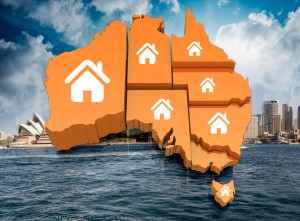National residential rental vacancy rate has recorded a large one month jump from 2.0% in March to 2.6% in April 2020, with the total number of vacancies Australia-wide now at 88,668 vacant residential properties. 
All states recorded increases in vacancy rates with the exception of Darwin which recorded a 0.1% decline.
The year on year comparison also revealed rises when the national rental vacancy rate in April 2019 was 2.3% compared to 2.6% recorded for April 2020, indicating the surge in vacancy rates is beyond seasonal rises.
Only Perth and Darwin recorded lower vacancy rates compared to this time last year.
Key Points
- National residential rental vacancy rate have surged from 0% in March to 2.6% in April 2020, with the total number of vacancies Australia-wide now at 88,668 vacant residential properties.
- All states recorded increases in vacancy rates with the exception of Darwin which recorded a 1% decline.
- Over the month, Capital city asking rents decreased 3% for houses and remain stable for units for the week ending 12 May 2020 to record asking rents of $537 per week for houses and $428 per week for units.
- CBD and holiday locations have been the hardest hit. The Sydney CBD now records a 8% rental vacancy rate.
| City | Apr-19 Vacancies |
Apr-19 Vacancy Rate |
Mar-20 Vacancies |
Mar-20 Vacancy Rate |
Apr-20 Vacancies |
Apr-20 Vacancy Rate |
| Sydney | 23,837 | 3.4% | 21,443 | 2.9% | 28,734 | 3.9% |
| Melbourne | 10,565 | 1.8% | 11,091 | 1.9% | 16,575 | 2.8% |
| Brisbane | 8,792 | 2.6% | 7,299 | 2.1% | 9,555 | 2.8% |
| Perth | 6,568 | 3.2% | 4,023 | 1.9% | 4,807 | 2.3% |
| Adelaide | 2,249 | 1.2% | 1,761 | 0.9% | 2,398 | 1.2% |
| Canberra | 811 | 1.2% | 589 | 0.9% | 824 | 1.2% |
| Darwin | 1,117 | 3.6% | 853 | 2.7% | 837 | 2.6% |
| Hobart | 185 | 0.6% | 238 | 0.8% | 442 | 1.4% |
| National | 77,645 | 2.3% | 67,371 | 2.0% | 88,668 | 2.6% |
SQM’s calculations of vacancies are based on online rental listings that have been advertised for three weeks or more compared to the total number of established rental properties. SQM considers this to be a superior methodology compared to using a potentially incomplete sample of agency surveys or merely relying on raw online listings advertised. Please go to our Methodology page for more information on how SQM’s vacancies are compiled.
CBD and Holiday Localities Hit the Hardest
Among the largest rises are the capital city CBD locations, particularly for the Sydney CBD where the vacancy rate has blown out to 13.8% – a record high on SQM’s series.
The Melbourne and Brisbane CBD locations have also recorded a huge rise in rental vacancies. Melbourne Southbank has risen to 13.0%.
The CBD itself rose to 7.6%.
Other holiday locations have also suffered with Surfers Paradise recording a vacancy rate of 8.5% and Noosa blowing out to 6.8%.
Suburban areas have faired better though rises have been recorded for most localities around the country.
| CBD | April-19 Vacancies | March-20 Vacancies | April 20 Vacancies |
| Sydney | 6.5% | 5.7% | 13.8% |
| Melbourne | 2.3% | 5.0% | 7.6% |
| Brisbane | 5.3% | 5.7% | 11.3% |
| Perth | 5.4% | 4.7% | 5.8% |
| Adelaide | 2.4% | 3.2% | 6.6% |
| Canberra | 4.8% | 2.2% | 4.6% |
| Darwin | 6.3% | 4.7% | 5.3% |
| Hobart | 1.3% | 1.3% | 2.5% |
Note: represents the postcodes of 2000, 3000, 4000, 6000, 5000, 2601, 0800, 7000 – Source: www.sqmresearch.com.au
Asking Rents suffer correction
Over the month, Capital city asking rents decreased 1.3% for houses and remained stable for units for the week ending 12 May 2020 to record asking rents of $537 per week for houses and $428 per week for units. National combined rents are now recording a 12 month decrease of 3.1%. 
Sydney, Melbourne and Perth recorded decreases in asking rents for both houses and units over the month.
Whilst Brisbane, Canberra and Hobart recorded decreases in house asking rents but minor increases in unit asking rents.
Darwin appears to be the only city that has remained relatively stable for the month with increases recorded in house rents of 2.7% but declines in unit rents of 2.0%.
Adelaide bucked the trend and recorded rent increases for both houses and units of 0.1% and 1.4% respectively.
This is one of the largest one month rises ever recorded on our vacancy rates series.
The blow out in rental vacancy rates for the major CBDs suggests a mass exodus of tenants occurred over the course of March and April.
This might be attributed to the significant loss in employment in our CBDs plus the drop off in international students. 
We are well aware of a surge in short term accommodation now being advertised for long term leasing.
The question now begs is how long will we see such high rental vacancies?
If it is sustained throughout the course of the year, then we can expect far deeper falls in rents which will be good news for tenants but a disaster for landlords.
There will also be economic consequences with further sharp falls in building approvals likely; thereby risking a major depression in our residential construction sector as well as the rather obvious risks for housing prices.
from Property UpdateProperty Update https://propertyupdate.com.au/major-correction-recorded-in-national-rental-market-vacancy-rates-surge-and-rents-fall/


No comments:
Post a Comment